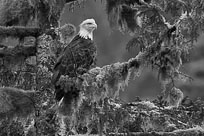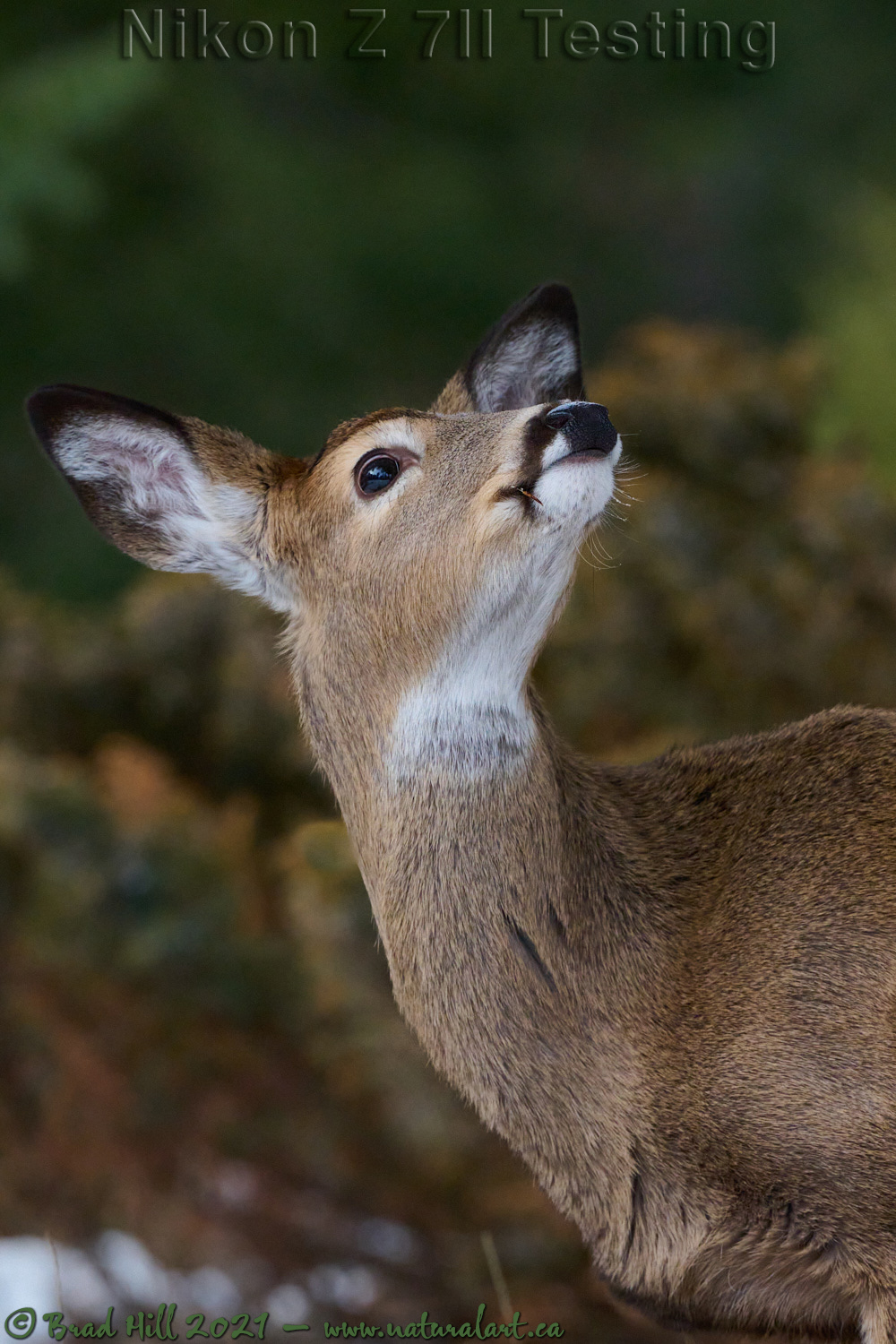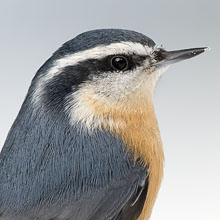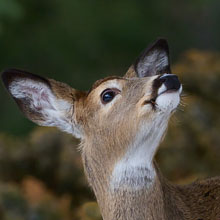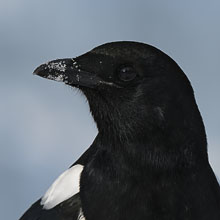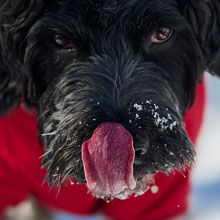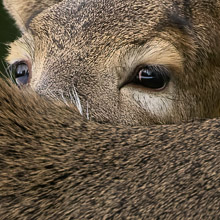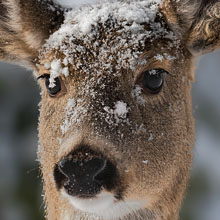Availability: Undetermined - Enquiries?
In the Field
Z 7II Testing - Wow...can that squirrel ever climb! Findlay Creek Region (East Kootenays), British Columbia, Canada. January 21, 2021.
This is another installment on my experiences with wildlife shooting using the Nikon Z 7II! But before I get into the technical topic associated with this image...a little about what's going on in this image...
Many regular visitors to this website may know that I am fortunate enough to live, quite literally, in the woods in the southeast corner of British Columbia, Canada. And, going hand-in-hand with living in the woods, is that our neighbours have either four legs or two wings...and are covered in either fur or feathers. Some of our most conspicuous neighbours are White-tailed Deer, and in any given season we'll have about 5-10 individuals that hang around quite close to our cabin. The "draw" to our cabin is twofold - for 3 seasons each year we have a pond with accessible water right outside our living room window...and the deer love to come drink out of it (in the winter the pond is frozen over and loses its appeal to the deer). And...most of our local predators (a list of those of concern to the deer includes cougars, wolves, coyotes, and both black and grizzly bears) avoid the immediate vicinity around our cabin, thus providing a bit of a "safe-haven" for the deer.
This young doe made its first appearance at our pond as a small fawn in early July of 2020. So in this shot it's about 8 months old. Yet, it is still as inquisitive and curious about things as it was as a tiny fawn - in this shot it was absolutely spellbound by a squirrel that was dancing along the branches high above its head. I have no clue why this doe was so entranced by the squirrel...maybe it was wishing it could climb with the same ease and aplomb as the squirrel? Whatever the reason, I found it fascinating to watch the deer watching the squirrel! ;-)
OK...back to the Z 7II. When I got my Z 7II I made the assumption that given it had the same sensor as the Z7 (which in itself was virtually identical to the D850 sensor in performance) it would have same ISO performance as the Z7. After a lot of shooting (and testing) I had capped the ISO of both my Z7 and D850 at ISO 3200 and hesitated to ever shoot them ISO's higher than this. But in my first month of shooting the Z 7II I noticed that its ISO 3200 shots looked...well...really good! Yes, there was a little luminosity noise visible...but it was very easily handled during post-processing. But what really struck me about the ISO 3200 images is that they simply didn't LOOK like high ISO images - the tonal ranges were still very good, and the colour was still great.
So...I decided to shoot a bunch of wildlife shots at ISO 4000. And...I noticed the same thing. Yep, arguably there was a tiny bit more luminosity noise but it was also very easy to handle in post. And the tonal range and colours still looked really good.
So...then I decided to jump up to ISO 6400 and shot a bunch more wildlife images, including this shot of the young White-tailed doe. And, after examining the resulting images I was EXTREMELY pleased. Sure...I could easily see some luminosity noise in the out-of-focus zones...but it was still very easily handled in post. And, the tonal range and the colour of the ISO 6400 images was still really good - in short, the images simply didn't LOOK like high ISO images!
To be clear, at this point I have NOT done systematic testing comparing Z7 and Z 7II images captured over a wide range of ISO's (I was hoping I could avoid that task!). So my ISO performance comments about the Z 7II should be considered both subjective and anecdotal at this point.
But the bottom line is that I am thrilled to know that I can shoot my Z 7II at ISO 6400 (and possibly a little higher) and still get very usable shots that don't LOOK like high ISO shots! ;-)
Here's a larger version (4800 pixel) of this curious young doe for your perusal:
• Z 7II Testing - Wow...can that squirrel ever climb: Download 4800 pixel image (JPEG: 5.3 MB)
ADDITIONAL NOTES:
1. This image - in all resolutions - is protected by copyright. I'm fine with personal uses of them (including use as desktop backgrounds or screensavers on your own computer), but unauthorized commercial use of the image is prohibited by law. Thanks in advance for respecting my copyright!
2. Like all wildlife photographs on this website, this image was captured following the strict ethical guidelines described in The Wildlife FIRST! Principles of Photographer Conduct. I encourage all wildlife photographers to always put the welfare of their subjects above the value of their photographs.
Behind the Camera
Z 7II Testing - Wow...can that squirrel ever climb! Findlay Creek Region (East Kootenays), British Columbia, Canada. January 21, 2021.
Digital Capture; Compressed RAW (NEF) 14-bit format; ISO 6400.
Nikon Z 7II paired with Nikkor 180-400mm f4E @ 400mm. Supported on Jobu Killarney tripod with Jobu HDMkIV gimbal head. VR on and in Sport mode. Single Point Area AF area mode.
1/2500s @ f9; -0.33 stop exposure compensation from matrix-metered exposure setting.
At the Computer
Z 7II Testing - Wow...can that squirrel ever climb! Findlay Creek Region (East Kootenays), British Columbia, Canada. January 21, 2021.
RAW Conversion from DNG to 16-bit PSD file (and JPEG files for web use), including all global and selective adjustments, using Phase One's Capture One Pro 21. Selective local adjustments performed using Capture One Pro's layers and masking tools. In this case selective adjustments were made on 4 separate layers and included one or more tweaks to exposure, blacks, clarity, and colour saturation. ALL noise reduction performed with Capture One Pro.
Photoshop modifications were limited to the insertion of the watermark and/or text.
Conservation
Z 7II Testing - Wow...can that squirrel ever climb! Findlay Creek Region (East Kootenays), British Columbia, Canada. January 21, 2021.
Species Status in Canada*: This species is not designated as at risk.
White-tailed Deer (Odocoileus virginianus) are one of the most widely distributed mammals in North America - they can be found in virtually all of southern Canada and in most of the American states. While whitetails are common now, in the late 1800's they were in serious risk of extinction - their populations had been reduced from about 40 million (across North America) to under 500,000. The conservation effort to return whitetails to numbers sufficient for long-term survival was massive and included strict harvest regulations, intense management, reintroductions, and habitat protection. Today, most populations in the United States do not represent original stock and the distinction of most historical subspecies is uncertain.
Whitetails resemble Mule Deer quite closely, and the two species overlap in distribution in western North America. The two species tend to prefer different habitats, with whitetails occupying more heavily forested land and along river valley bottoms, while muleys tend to prefer uplands and montane areas. On rare occasions, the two species will interbreed. Occasionally the offspring are fertile, but in most cases they are sterile.
This whitetail fawn was photographed in the Columbia Valley of the East Kootenays. While this species is not currently considered at risk, many ecosystems within the Columbia Valley face development pressure, including pressure from logging operations.
*as determined by COSEWIC: The Committee on the Status of Endangered Wildlife in Canada










